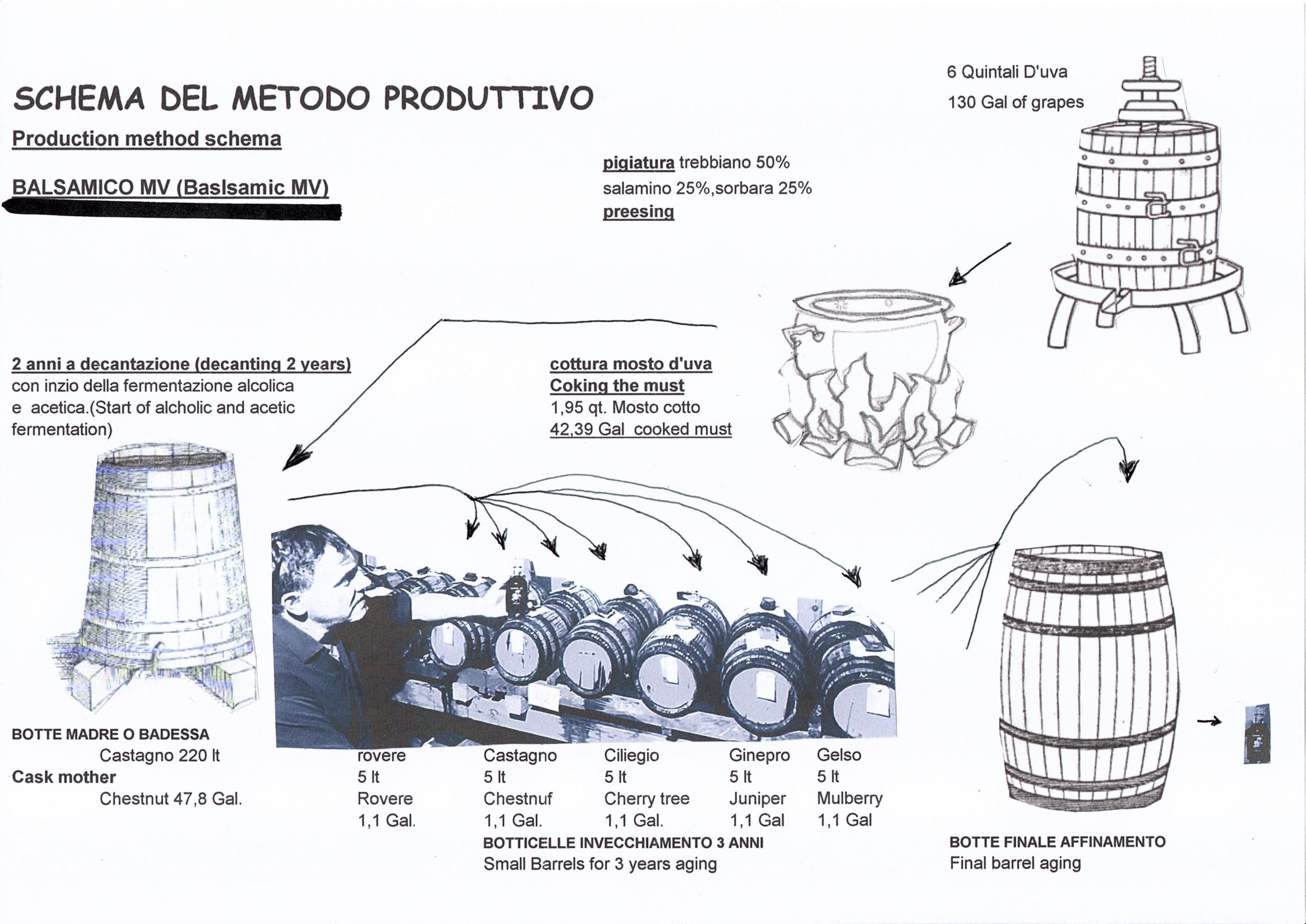
CHARACTERISTICS/ PACKAGE / PRODUCTIVE SYSTEM
ORIGIN:
which I get by cooking only fermented grape musts from the Reggio Emilia area.
Once the product is ready, it is transferred from the wooden casks to a large oak barrel and left to mix and rest for another year at least.
Our product is gluten-free with no added sulfites, no caramel, preservatives, colorings orartificial aromatic additives. It is a completely NATURAL and complex product, with a bright brown color and bittersweet taste, the right balance between density and acidity, rich in aromaabsorbed from the different wooden casksin which they were aged in. The scent is decidedly strong,but at the same time harmonious and balanced by years of aging.
EXPIRY DATE:
The product does not expire. We indicate about 10 years.
STORAGE:
The bottle has a wax sealed cork-like stopper and a screen-printed profile portrait of
Marco designed by a friend, Carlo Dotti. The bottle comes in a silkscreened
cardboard box.
particularly on grilled meats and vegetables and.
“Balsamic M.V”. can be used for the preparing accompanying sauces with brief
cooking periods.
The procedure takes approximately 7 years, in a natural environment: hot in summer, cold in the winter. The product undergoes profound changes over time and aging takes place in casks of different types of wood. Each of these wooden casks give the vinegar a particular aroma.
Balsamic Vinegar is refined over time thanks to the annual refilling or topping off with cooked grape must transferred from the “badessa” or “botte madre” (mother barrel) containing fermented cooked grape must acetified for two years.
After the 6th year the product is ready.
Cooking Grape Must
As we mentioned before, the grapes used for the cooking the grape must are locally grown in the province of Reggio Emilia.
Cooking the grape must is one of the most important and delicate phase of the process.
The grape must is cooked over an open fire until it’s reduced approximately to a third of its original volume.
It has two important purposes:
1. To sterilize the must from unwanted substances. Impurities are skimmed away and discarded because it could alter fermentation which should take place only in the barrel.
2. To reduce the grape must to a concentrate of about one third of its volume by evaporation. Cooking induces a series of reactions, which mainly
involve sugar concentration that contribute to define color and part of the aroma that is typical of balsamic vinegar. The sugar content also provides nourishment for the yeast. Yeast transforms sugar into alcohol, producing nourishment for acetic bacteria which then turns the alcohol into acetic acid.
The grape must is simmered for about 12 hours. It is the manufacturer’s responsibility to avoid excessively over cooking at high temperatures as the sugar will caramelize, blocking fermentation, thus giving the must an unpleasant, scorched taste.
Alcoholic fermentation and Acetic oxidation
To obtain a must with 24% sugar and 6% alcohol the cooked must is removed from the kettle and cooled, then it is transferred to holding tanks “badessa” and combined with an older Balsamic Vinegar that includes various active yeasts and bacteria which help turn the juice into acetic acid (vinegar).
The cooked must actually benefits from the alternating cold winter season and the summer heat.
The cold temperature allows the must to rest and mature; the grape must is decanted and becomes a naturally clear color.
In the summer the vinegar bacteria are set in motion and transforms the alcohol of the must into acetic acid.
During summer months the area should be ventilated and premises kept dark.
This natural chemistry allows Balsamic Vinegar to develop and improve for years.
Maturation and Aging in Wooden Casks
The fermented and acetified must in the “badessa” can now be transferred in small casks of 5/6 liters each, where the vinegar goes through what is called “maturation” and aging.
At this point it is fundamental the care and the attention in which the producers choose the various types of wooden casks to use in the production of the Balsamic Vinegar. Most producers use a variety of woods.
The woods generally used are:
• chestnut, which yields color and facilitates acidification;
• oak, strong and compact, confers a vanilla aroma;
• cherry, gives the condiment a fruit aroma, sweet and delicate;
• juniper, defines a strong aroma of resinous wood.
MATURATION AND AGING WOODEN CASKS
The fermented and acetified must in the “badessa” can now be transferred in small casks of 5/6 liters each, where the vinegar goes through what is called “maturation” and aging.
At this point it is fundamental the care and the attention in which the producers choose the various types of wooden casks to use in the production of the Balsamic Vinegar. Most producers use a variety of woods.
The woods generally used are:
• chestnut, which yields color and facilitates acidification;
• oak, strong and compact, confers a vanilla aroma;
• cherry, gives the condiment a fruit aroma, sweet and delicate;
• juniper, defines a strong aroma of resinous wood.
AGING AND REFINING PROCEDURE:
1st year: each barrel “badessa” is filled to 80% of their capacity with cooked must for fermentation and acidification and it is left to rest for at least two years.
• 3rd year: the vinegar is decanted and transferred to the 5-liter casks for aging.
During this phase it is necessary to maintain the volume constant in every cask over the years by refilling or “topping up” or “topping off” with other vinegar (each year the cooked must loses approximately 10% of its volume through evaporation).
• 6th year: the finished product is withdrawn from the casks and put to rest and refine in a large oak barrel.
• 7th / 8th year: the Balsamic Vinegar is ready.
CONTROL:
Chemical characteristics: each batch is controlled for density and acidity. The “M.V. Balsamic Vinegar” has a density of approximately 1.25/ml and about 6% of acidity.
• Organoleptic characteristics: Before I consider the “M.V. Balsamic Vinegar” suitable for bottling, each batch is examined for taste, visual characteristics and aroma.
INFORMAZIONI/VALORI NUTRIZIONALI
aggiornati per L.104061932-118111965-126092002
“Balsamic M.V”.
Valori Nutrizionali medi per 100 ml.
Avarage nutrition facts for 100 ml.
Valeurs nutritionelles moyennes puor 100 ml.
Nahrwerte pro oder 100 ml.
Energia/Energy/Energie/Brennwert: kj 1322 – Kcal 311
Grassi totali / Total fat /Matières grasses/Fett: 0 g
di cui saturi/ Saturated fat/Dont acides gras
saturès/Davon gesàttigte Fettsàuren: 0 g
Carboidrati totali/Glucides/
Total Carbohydrates:/ Kohlenhydrate: 72 g
di cui zuccheri/Sugar/Dont sucres/davon Zucker: 72 g
Fibre / Fiber/Fibres: 0 g
Sodio/Sodium/Natrium: 0,03 g
Proteine/Protein/Protèines/EiweiB: 1,2 g
Sale/Salt/Sel/Salz: 0,075 g
Informazioni generali per tutti i prodotti:
.-Fare attenzione alla data di scadenza;
.-Conservare a temperatura ambiente in luoghi asciutti
.-Dose giornaliera raccomandata (Reg. (UE) n° 1169/20119,
basato su una dieta di 2000 kcal/8400.
.-Il calcolo finale dell’energia è stato effettuato come previsto
dal regolamento (UE) n° 1169/2011 considerando
i valori medi di acidi organici.



